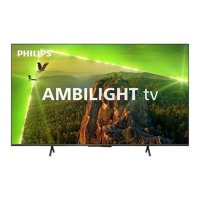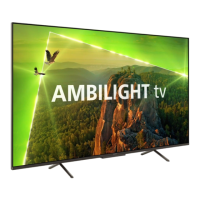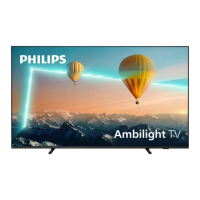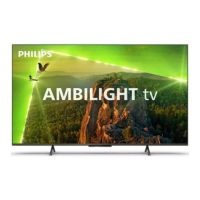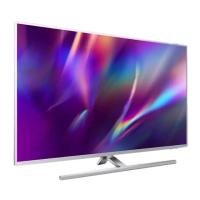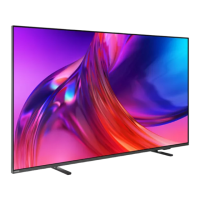
Do you have a question about the Philips 43PUS8319 and is the answer not in the manual?
| Screen Size | 43 inches |
|---|---|
| Smart TV | Yes |
| HDMI Ports | 4 |
| Resolution | 3840 x 2160 (4K Ultra HD) |
| Display Technology | LED |
| HDR Support | Dolby Vision, HDR10+, HLG |
| Audio Output | 20W |
| Wireless Connectivity | Wi-Fi, Bluetooth |
| Ambilight | 3-sided |
Overview of home screen layout, apps, and content discovery.
Finding and registering your TV's model and serial numbers for support.
Accessing TV help, diagnostics, and user manual features.
Performing diagnostic tests to check TV performance and identify issues.
Information on contacting support, repair services, and product care.
Overview of the TV remote control, its keys and functions.
Steps to pair the remote control with the TV for Bluetooth and Alexa functionality.
IR sensor, battery replacement, cleaning, and joystick control.
Important safety information and guidelines to follow before using the TV.
Guidance on optimal TV positioning for viewing and ventilation.
Instructions for connecting the power cable and turning the TV on.
General advice on connecting devices for optimal picture and sound.
Connecting terrestrial antennas and satellite dishes for signal reception.
Connecting video (HDMI) and audio (Optical) devices for optimal output.
Connecting headphones and mobile devices for screen mirroring.
Connecting USB drives and Bluetooth devices for extended functionality.
Connecting a computer to use the TV as a monitor via HDMI.
Viewing and selecting available input sources for connected devices.
Changing the name of connected devices for easier identification in the source menu.
Information on TV channels, switching, and channel lists.
Guide to installing channels via antenna, cable, and satellite.
Copying channel lists between TVs for convenience.
Managing channel lists, renaming, filtering, and options.
Creating and managing favourite channel lists.
Using teletext services, subtitles, and text options.
Understanding what is required to use the TV Guide feature.
Navigating, tuning, and viewing programme details in the TV Guide.
Introduction to Freeview Play features and benefits for UK users.
Step-by-step guide on how to access and use Freeview Play services.
Viewing media files from a USB drive connected to the TV.
Accessing media files stored on a computer or Network Attached Storage.
Viewing photos, including slideshows and options for photo display.
Playing video files from various sources and managing video playback options.
Playing music files and managing music playback options.
Accessing quick menus and frequently used TV settings.
Adjusting picture style, contrast, colour, sharpness, and screen format.
Selecting sound styles and personalizing audio preferences.
Controlling HDMI sound systems and audio output via EasyLink 2.0.
Configuring Ambilight effects, personal colours, and Ambisleep wake-up function.
Setting up sunrise alarms using Ambilight, music, and weather for a wake-up experience.
Connecting the TV to the internet wirelessly or via Ethernet cable.
Configuring network settings, Wi-Fi, and device names.
Optimizing power usage with screen off, timers, and standby settings.
Configuring USB devices, EasyLink HDMI-CEC, and HDMI Ultra HD settings.
Setting screensavers, location modes, and managing demo videos.
Enabling features for accessibility and user assistance.
Setting up channel locks, programme locks, and app locks.
Adjusting TV language, audio/subtitle preferences, and clock settings.
Optimizing energy saving through screen off, switch-off timers, and no-signal timers.
Accessing and using the gaming control bar for in-game information and settings.
Initial configuration and agreement to terms for using Smart TV features.
Browsing, selecting, and installing applications from the TV's app store.
Accessing and enjoying Netflix on the TV with a subscription.
Accessing popular movies and TV shows with an Amazon Prime membership.
Watching and exploring videos on YouTube via the TV app.
Introduction to Amazon Alexa voice control capabilities on the TV.
Setting up and using Alexa for voice control operations on the TV.
Examples of voice commands to control the TV using Alexa.
Configuring Google Assistant for voice control of TV functions.
Steps to update TV software via internet or USB for new features and fixes.
Checking current software version and viewing update history.
Enabling automatic updates to keep the TV software current.
Information on the TV's energy efficiency class and consumption.
List of EPREL registration numbers for various TV models.
Guidelines for proper disposal of the TV and its batteries.
Details on TV power, signal reception, and screen resolution specifications.
Supported video and computer resolutions for various input sources.
Specifications for the TV's audio output and multimedia connectivity.
Details on TV ports, wireless connectivity, and supported file systems.
Advice for diagnosing and resolving common TV issues.
Solutions for power, remote control, and channel reception problems.
Troubleshooting common problems with picture and sound.
Resolving HDMI/UHD, USB, Wi-Fi, and language problems.
Important safety instructions to prevent electric shock, fire, injury, or damage.
Instructions for cleaning the screen and safety for environmental conditions.
Important warranty terms, safety warnings, and pixel/backlight characteristics.
Details on CE, UKCA compliance, and EMF standards.
Information regarding HDMI interface terms and HEVC video decoding technology.
Copyright and trademark information for DTS:X and Dolby ATMOS audio technologies.
Information about Wi-Fi Alliance certification and other registered trademarks.
Information and licenses for open source software components used in the TV.
Disclaimer regarding potential changes or termination of third-party services or software.
